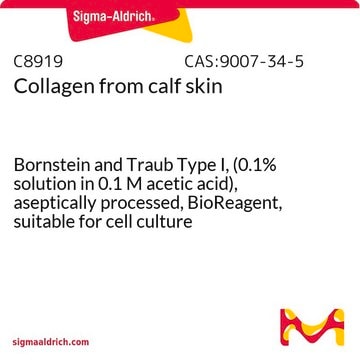C7624
Collagen human
Bornstein and Traub Type I, recombinant, expressed in Nicotiana tabacum (tobacco)
Sinonimo/i:
Collage™
About This Item
Prodotti consigliati
Origine biologica
human
Livello qualitativo
Ricombinante
expressed in Nicotiana tabacum (tobacco)
Saggio
>90% (SDS-PAGE)
Forma fisica
liquid
Concentrazione
2.5-3.5 mg/mL protein (Sircol method)
tecniche
cell culture | mammalian: suitable
Condizioni di spedizione
wet ice
Temperatura di conservazione
2-8°C
Informazioni sul gene
human ... COL1A1(1277) , COL1A2(1278)
Cerchi prodotti simili? Visita Guida al confronto tra prodotti
Descrizione generale
Stato fisico
Nota sulla preparazione
To prepare a collagen gel the fibrillogenesis buffer contains 162 mM sodium phosphate dibasic (Na2HPO4) adjusted to pH 11.2 with 10 N NaOH, filter sterilized. Mix 9 volumes of Collagen at a concentration of 0.3%-1% with 1 volume of fibrillogenesis buffer. Mix well and incubate for 4 to 16 hours at 25°C to 27 °C. Higher concentration of collagen solution might need optimization. Thiis preparation will not spontaneously form a gel in PBS or cell culture medium.
Preparation of collagen sponge: concentrate gel to 10 mg/ml - 100 mg/ml by centrifugation, freeze dry. Crosslink by common methods found in the scientific literature such as 1-Ethyl-3-[3-dimethylaminopropyl]carbodiimide hydrochloride (EDC), Glutaraldehyde or thermal dehydration.
Other forms: membranes, sheets, fibers can be prepared by methods commonly used with other types of collagen.
Note legali
Codice della classe di stoccaggio
13 - Non Combustible Solids
Classe di pericolosità dell'acqua (WGK)
nwg
Punto d’infiammabilità (°F)
Not applicable
Punto d’infiammabilità (°C)
Not applicable
Certificati d'analisi (COA)
Cerca il Certificati d'analisi (COA) digitando il numero di lotto/batch corrispondente. I numeri di lotto o di batch sono stampati sull'etichetta dei prodotti dopo la parola ‘Lotto’ o ‘Batch’.
Possiedi già questo prodotto?
I documenti relativi ai prodotti acquistati recentemente sono disponibili nell’Archivio dei documenti.
I clienti hanno visto anche
Il team dei nostri ricercatori vanta grande esperienza in tutte le aree della ricerca quali Life Science, scienza dei materiali, sintesi chimica, cromatografia, discipline analitiche, ecc..
Contatta l'Assistenza Tecnica.











